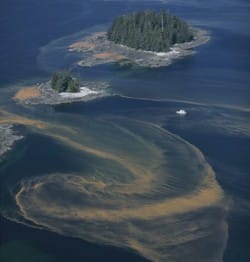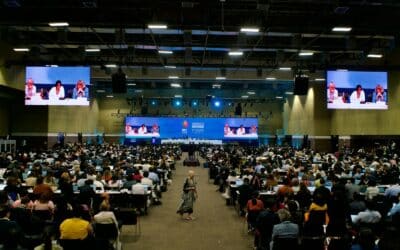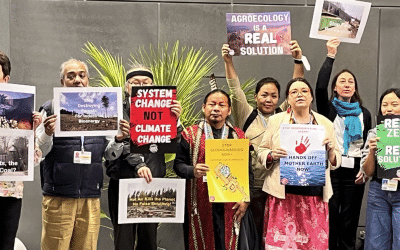
A phytoplankton bloom swirls in the waters off islands in southeast Alaska. Nutrients such as iron encourage the tiny marine plants to grow. Studies show the plankton, like trees, remove carbon dioxide gas from the atmosphere, and so could serve as natural carbon sinks. But a plan by a U.S. firm to profit by seeding plankton blooms with iron and selling co-called carbon credits is polarizing experts, many of whom worry that the environmental impacts of such a project are still poorly understood. Photograph by Bill Curtsinger/National Geographic/Getty Images
by Kelly Hearn (National Geographic News)
Global warming is heating up opportunities for companies that can find ways to pull carbon dioxide (CO2) out of the atmosphere and sell “carbon credits” on emerging markets.
But one company’s attempt to dip its toes into free-market climate solutions appears to be headed for a high-seas standoff.
In the coming days to weeks, Planktos, a small California-based “ecorestoration” company, will use a 115-foot (35-meter) research ship to dump a hundred tons of iron dust into international waters some 200 miles (322 kilometers) west of the Galápagos Islands.
Iron—a nutrient naturally carried into the ocean by wind—encourages plankton growth, which can absorb atmospheric CO2, a greenhouse gas.
Planktos ultimately wants to fertilize plankton blooms, measure the carbon they capture, and sell the corresponding credits (related: “Extreme Global Warming Fix Proposed: Fill the Skies With Sulfur” [August 4, 2006]).
Companies that emit greenhouse gases can buy these credits to offset their contributions to global emissions.
Russ George, Planktos’ CEO, testified last week about the project before a U.S. congressional committee. He says nearly a dozen scientific studies are conceptually on his side.
The 57-year-old, who describes himself as a classical ecologist and businessman, says he is simply mimicking Mother Nature by giving greenhouse gas-sucking seas and trees a leg up.
But several environmental groups and marine scientists are raising red flags, while U.S. regulators are asking questions about accountability.
And at least one opponent to the plan isn’t waiting for official regulatory action.
Greenpeace co-founder Paul Watson told National Geographic News that his group the Sea Shepherd Conservation Society plans to send a ship to intercept Planktos’ vessel in open waters.
Carbon Solution or Marine Pollution?
Phytoplankton are tiny floating plants that, like trees, convert CO2 gas from the atmosphere into carbon stored in their tissues.
Some plankton are eaten by marine animals, which return the carbon to the atmosphere during respiration. But some of the plants die and sink to the ocean depths, effectively sealing the carbon away.
“Both plankton and forest restoration projects remove enormous quantities of global-warming CO2 from the atmosphere,” says a statement on Planktos’s Web site.
But the international conservation group WWF, Galápagos National Park, Greenpeace, and Canadian-based ETC have spoken out opposing the plan.
The groups cite scientific studies that say large-scale iron enrichment schemes have too many potential consequences and too few hypothetical benefits.
And the Charles Darwin Foundation, a nonprofit group dedicating to preserving the Galápagos, said in a recent advisory that Planktos’ project “is an unnecessary bet whose possible effects are totally unknown given that there has not been an environmental impact statement.”
Some studies have suggested that sustained fertilization can create low- to no-oxygen conditions in the iron-enriched waters or trigger blooms of harmful types of plankton.
Sally Chisholm, a researcher at Massachusetts Institute of Technology, has published articles about the topic.
Such conditions, she writes, can “shift the microbial community toward organisms that produce greenhouse gases such as methane and nitrous oxide, with much higher warming potentials than CO2.”
Meanwhile the U.S. Environmental Protection Agency (EPA) says it is evaluating Planktos’ plan.
“EPA has informed Planktos that its planned project might require a permit under the Marine Protection, Research, and Sanctuaries Act [also known as the Ocean Dumping Act],” the agency’s Dale Kemery told National Geographic News in an email last week.
“Based on the information currently available, EPA is unable to determine that Planktos’ proposed actions would be subject to regulation under the Ocean Dumping Act. The agency will continue its inquiry into this matter.”
In June EPA sent a memo to the International Maritime Organization (IMO), an organization established by the United Nations to work with governments and the shipping industry to prevent marine pollution.
The document informed IMO that EPA has no power to regulate Planktos, because the company had chosen not to fly a U.S. flag—a move that would allow the ship to avoid U.S. regulations.
The memo also advised the member states of the London Convention—a global agreement on pollution controls—to carefully evaluate Planktos’ plans.
Scientific Endeavor
Planktos officials defended their project in a telephone interview and series of emails with National Geographic News, saying they are being attacked by fringe environmentalists and mischaracterized by U.S. officials.
W. David Kubiak, the company’s communication director, said the two-year, six-bloom pilot projects are not large scale.
The project, he says, is more about correcting what at least one scientific study says are diminishing phytoplankton populations.
“The most critical issue that we originally set out to address was this collapse at the base of the ocean food chain,” Kubiak said.
“All the climatic and economic benefits that emanate from that restoration work are wonderful to be sure but are not the most critical points of this work.”
Planktos’ company documents also say that their pilot projects will make up the longest, largest, and most comprehensive study of phytoplankton ecology.
In addition to studying carbon-cycle implications, the company says it plans to evaluate factors such as the effects of the blooms on ocean acidity and nitrogen levels as well as populations of marine life that graze on the plankton.
But not all scientists agree on the extent of the plankton decline, noting that natural cycles of productivity make it hard to detect long-term trends based on year-to-year variability.
Some experts also dispute the claim that the project represents a significant scientific undertaking.
Planktos, they say, has a relatively small ship, limited scientific expertise, and only basic equipment to sample and measure changes.
As for the regulatory debate, Planktos’ Kubiak says the firm has made no decision about which flag to fly on its ship. He and company CEO George both said the company asked EPA for guidance but failed to receive information.
“We still hope to work with them constructively and are postponing any ship decisions until that is clarified,” Kubiak said in an email.
“Wondrous Feature”
CEO George, meanwhile, said the project is still planned to launch in late July or early August.
Planktos’ project is downwind and down current from the Galápagos Islands and would not impact that ecosystem in any way, he said.
“There are already [plankton] blooms around Galápagos,” he added. “How is it that the wondrous feature that makes the Galápagos such a treasure is somehow a problem?”
He also challenged critics who warn of potentially negative environmental consequences of iron-enhanced plankton blooms. “Where is there a documented case of any of those concerns really being exhibited?” he asked.
Due to short time frames and scales, no studies have directly proven unintended negative consequences of large-scale ocean fertilization.
But MIT’s Chisholm and other scientists have expressed doubts that the project won’t have environmental repercussions.
Calling the idea environmentally benign “is inconsistent with almost everything we know about aquatic ecosystems,” she wrote.
Many studies predict that iron would alter the ocean’s food webs and biogeochemical cycles in unintended ways.
“We have learned this from inadvertent enrichment of lakes and coastal waters with nutrients from agricultural runoff, something we have been trying to reverse for decades,” she wrote.
Ken Buesseler, a senior scientist at the Woods Hole Oceanographic Institution, says that the effectiveness of ocean fertilization as a means of mitigating climate change has not been a focus of prior studies and is not well known.
“Only carbon that reaches the deep sea is isolated from the atmosphere long enough to impact atmospheric CO2 and hence climate,” he said, adding that it is difficult to measure how much carbon gets stored.
“So there is little evidence to go on when making claims about the efficacy of a commercial operation.”
Originally posted to National Geographic News.


